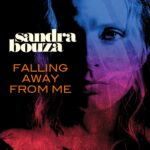 2020’s been a funny old year for album releases. It’s difficult for artists to decide what to do with their new material; postpone and wait for the opportunity to tour in support of the album or take advantage of period when there are fewer albums to compete with. Or maybe after the album’s complete, there’s an urge to just get it out there. “Falling Away from Me” was released across the pond in February 2020 and presumably the intention was to release it here to coincide with a summer tour. And along came COVID. Whatever the reasoning, after a lengthy musical apprenticeship covering many different countries, Sandra Bouza has decided to release her first album, “Falling Away from Me” in October 2020.
2020’s been a funny old year for album releases. It’s difficult for artists to decide what to do with their new material; postpone and wait for the opportunity to tour in support of the album or take advantage of period when there are fewer albums to compete with. Or maybe after the album’s complete, there’s an urge to just get it out there. “Falling Away from Me” was released across the pond in February 2020 and presumably the intention was to release it here to coincide with a summer tour. And along came COVID. Whatever the reasoning, after a lengthy musical apprenticeship covering many different countries, Sandra Bouza has decided to release her first album, “Falling Away from Me” in October 2020.
It’s an album that proudly displays its creator’s influences throughout. There are elements of pop, jazz, blues and rock, but the foundation of the work is its tight funk rhythms created by the understated combination of guitar, bass and drums with occasional seasoning of keyboards, a sample or a piece of electronica. Without ever sounding derivative, the album hints instrumentally and vocally at a number of artists; more on that later. The individual stamp that defines the album, is the highly personal and confessional lyrics of the eight songs, dealing with bad choices in lifestyle and relationships. It’s an album of funky torch songs.
The mid-tempo jazz-blues of “Not Like Me” is a nod in the direction of Robert Cray’s “Right Next Door”, which features not only a powerful lead vocal, but some lovely layered and ethereal backing vocals as well, while “Stone Junction” is a bit more robust with a punchy bassline and some clipped Steve Cropper-like guitar backing up a tale of misplaced nostalgia for a corrosive past. “Human Connection” has some electronic percussion and a pumping bassline that wouldn’t sound out of place on a Pet Shop Boys song and the backing vocals towards the close are reminiscent of Clare Torry on “Great Gig in the Sky”.
The songs demonstrate Sandra’s vocal versatility across a range of dynamics; at times she has a hint of Chrissie Hynde, “Losing You” has the delicacy of Judie Tzuke and the highly personal closer “Wrong Songs” is a nod towards Sade; there’s even a touch of Ella’s scat singing towards the end.
The album is a strong collection of songs pulled together with an autobiographical thread that gives Sandra Bouza an opportunity to demonstrate her vocal and songwriting abilities and it certainly achieves that goal. When things get back to whatever the new normal is, I’ll be keen to see Sandra Bouza playing live in the UK.
“Falling Away from Me” is released in the UK on Friday October 30th on Sabucedo Records (SB003).
It’s time to move away from albums, gigs and photos for a while and take a look at some of the music-themed books that have kept me sane on buses, trains and planes during 2015. By sheer chance, I’ve managed to pick out quite a nice variety of styles and themes, so the selection staggers from light-hearted memoirs through serious autobiography to high technology and serious crime (no, I don’t mean the new Coldplay album). So, as ever, in no particular order, here we go.
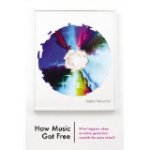 “How Music Got Free” – Stephen Witt
“How Music Got Free” – Stephen Witt
There’s a myth that’s been perpetuated about the origins of the current situation where we have a generation that won’t pay for music and a generation that doesn’t even recognise the concept of paying for music. What Stephen Witt’s book achieves is a comprehensive demolition of the myth that file-sharing came about because of some sort of people’s revolution where millions of like-minded people decided to share their digital music collections. This well-researched work picks out the various converging paths ultimately leading to the digital devaluation of music. The book explores the bureaucracy that bedevilled the adoption of a standard compression algorithm, the greed of the major music labels as they rushed into the highly lucrative CD market, the failure of the majors to react to the phenomenon of file compression (and increasing online transfer speeds which made sharing a viable proposition) and the outright criminality involved in stealing and counterfeiting masters from CD pressing plants. It’s a fascinating but ultimately depressing book.
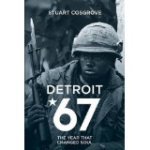 “Detroit 67: The Year that Changed Soul” – Stuart Cosgrove
“Detroit 67: The Year that Changed Soul” – Stuart Cosgrove
Stuart Cosgrove has picked out a pivotal year in the history of Motown and imposed a structure of a chapter per month (it works pretty well) which sets the upheavals at Motown against a backdrop of riots in Detriot, unrest in the police force and a general national malaise. Berry Gordy plays a central role in the well-known story of Diana Ross’s advancement at the expense of the other Supremes (and the expulsion of Florence Ballard), but Stuart Cosgrove delves deeper into the sickness at the heart of the company, dealing with the unease of major artists and the ultimate defection of the Holland/Dozier/Holland writing/production team. The book goes far beyond music biography by showing these events in the context of a city in meltdown with riots on either side of the racial divide and a brutal, corrupt police force fanning the flames. It’s a fascinating read, although there are far too many typos in the Kindle edition.
 “Fortunate Son” – John Fogerty
“Fortunate Son” – John Fogerty
Confession time: the first song I performed in public was Creedence’s “Up Around the Bend” in a school band which included some good musicians and a future nuclear physicist, and me. I was a fan from an early age. “Fortunate Son” is John Fogerty’s attempt to put the record straight after accusations and counter-accusations, suits and counter-suits with his former band members Doug Clifford and Stu Cook. The book is unflinchingly honest throughout; John Fogerty isn’t trying a whitewash here. He owns up to his mistakes and errors of judgement and this gives him the right to expose others’ lies and hypocrisy. It’s difficult not to empathise with him in his battles with Saul Zaentz and the former Creedence members: he wrote the songs, after all. “Fortunate Son” pivots around John Fogerty’s meeting with his second wife, Julie, who brought order to his chaotic life and pushed him back towards popular and critical recognition. It’s good, it’s honest, it’s straightforward and it’s delivered in an authentic John Fogerty voice.
 “Unfaithful Music and Disappearing Ink” – Elvis Costello
“Unfaithful Music and Disappearing Ink” – Elvis Costello
Declan McManus has an awful lot of stories to tell and, not surprisingly, he has a gift for writing and storytelling. “Unfaithful Music…” is a cracking read, giving an insight into the creation of some wonderful music, and life in the music business bubble. The book doesn’t follow a straightforward chronological structure; it’s much more like a conversation in the pub with each observation triggering another digression. There are some difficult events to deal with (the Stephen Stills/Ray Charles incident for example) and they’re all dealt with in a very matter of fact way. The book skips over some big chunks of Elvis Costello’s life, but the ones he does tackle are done with honesty and candour. The names that crop up as the story unfolds are a history of popular music, but this never feels like name-dropping, they’re just people who happen to have been around at certain times. This is a wonderful book.
“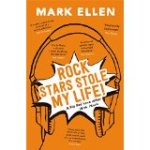 Rock Stars Stole My Life” – Mark Ellen
Rock Stars Stole My Life” – Mark Ellen
Mark Ellen’s memoir is a breezy and self-deprecating run through a life as a pop journalist, radio presenter, TV presenter and publisher. He gives an inside view on life at the NME in the seventies, The Old Grey Whistle Test and the Live Aid broadcast, all delivered in a jaunty style that’s very easy to read. He’s met and worked with some amazing people (again, it’s all matter-of-fact rather than name-dropping), but being a member of Ugly Rumours with Tony Blair takes some beating. Most of the book is fairly gentle humour, smiles rather than guffaws, but Mark Ellen saved the best for last. His account of the mayhem aboard Rihanna’s ill-conceived and farcical round-the-world-in-seven-days tour made me laugh out loud. The entire book’s funny, but this piece was hilarious.
If you don’t see anything you fancy there, Chrissie Hynde’s “Reckless” and Bob Harris’s “Still Whispering After All These Years” are both well-written and interesting biographies.
We reviewed Bob Malone’s excellent “Mojo EP” earlier this year and a couple of months later we sent Allan out to the badlands of Southend-on-Sea to see the final show of Bob’s UK tour. We were so impressed that we asked Bob to contribute to this feature. Here’s Bob’s festive favourite five:
‘Tis the season, and all that sort of thing; I can’t lie – I get radically sentimental about the holidays. For most of the year, I bash pianos, sing songs of alienation and heartbreak, and knock out one-nighters like the road warrior that I am, but come Christmakuh, don’t come around here looking for any of that action – I’ll be busy baking cookies, bitchez! These five records mean a lot to me, and they are what I think of when I think of this time of year.
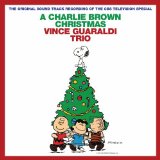 “A Charlie Brown Christmas” – Vince Guaraldi Trio Vince was one of the great jazz pianists, with a magical, melodic, understated style all his own. This music is the perfect companion to what was probably most perfect Christmas TV special ever made. You’ll smile, you’ll reflect quietly, you get a little melancholy, and you will dig that swinging rhythm section every year for the rest of your life. Oh, and I have this record on green vinyl – you know you want one. Timeless.
“A Charlie Brown Christmas” – Vince Guaraldi Trio Vince was one of the great jazz pianists, with a magical, melodic, understated style all his own. This music is the perfect companion to what was probably most perfect Christmas TV special ever made. You’ll smile, you’ll reflect quietly, you get a little melancholy, and you will dig that swinging rhythm section every year for the rest of your life. Oh, and I have this record on green vinyl – you know you want one. Timeless.
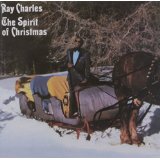 “The Spirit Of Christmas” – Ray Charles This record is so good, you don’t even have to wait for the holidays to put it on. Crazy hip arrangements, and Ray singing his ass off and playing a sweet, sweet Fender Rhodes throughout. He even manages to make “Rudolph the Red Nosed Reindeer” sound badass. There will never be another Brother Ray, so bow down and dig. I should note, however, that this record has the widest bad-album-cover-to-great-music spread ratio ever. A book definitely not to be judged by its cover.
“The Spirit Of Christmas” – Ray Charles This record is so good, you don’t even have to wait for the holidays to put it on. Crazy hip arrangements, and Ray singing his ass off and playing a sweet, sweet Fender Rhodes throughout. He even manages to make “Rudolph the Red Nosed Reindeer” sound badass. There will never be another Brother Ray, so bow down and dig. I should note, however, that this record has the widest bad-album-cover-to-great-music spread ratio ever. A book definitely not to be judged by its cover.
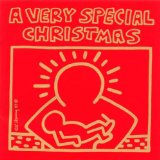 “A Very Special Christmas” – Various Artists This mid 80s collection sold gazillions and is full of great tracks – Bruce Springsteen & the E Street Band doing the great Charles Brown’s “Merry Christmas Baby” (way cool, but not as good as the 1977 bootleg of Bruce doing “Santa Claus Is Coming To Town,” which just can’t be touched – I’m from New Jersey – this shit is IMPORTANT!), Chrissie Hynde’s snow-meltingly sexy version of “Have Yourself A Merry Little Christmas,” and Madonna totally nailing “Santa Baby” – and I frigging HATE Madonna – but credit where credit is due. Most importantly, though, it’s got Run – D.M.C. doing “Christmas In Hollis” – which just might possibly be the greatest thing ever… “It’s Christmastime in Hollis, Queens, mom’s cookin’ chicken and collard greens…” Yes, Indeed. Oh and speaking of Charles Brown, everyone needs to own “A Very Special Christmas II” just for the recording of his duet with Bonnie Raitt on the aforementioned “Merry Christmas Baby.” It’s the kind of thing Top-5 lists were made for.
“A Very Special Christmas” – Various Artists This mid 80s collection sold gazillions and is full of great tracks – Bruce Springsteen & the E Street Band doing the great Charles Brown’s “Merry Christmas Baby” (way cool, but not as good as the 1977 bootleg of Bruce doing “Santa Claus Is Coming To Town,” which just can’t be touched – I’m from New Jersey – this shit is IMPORTANT!), Chrissie Hynde’s snow-meltingly sexy version of “Have Yourself A Merry Little Christmas,” and Madonna totally nailing “Santa Baby” – and I frigging HATE Madonna – but credit where credit is due. Most importantly, though, it’s got Run – D.M.C. doing “Christmas In Hollis” – which just might possibly be the greatest thing ever… “It’s Christmastime in Hollis, Queens, mom’s cookin’ chicken and collard greens…” Yes, Indeed. Oh and speaking of Charles Brown, everyone needs to own “A Very Special Christmas II” just for the recording of his duet with Bonnie Raitt on the aforementioned “Merry Christmas Baby.” It’s the kind of thing Top-5 lists were made for.
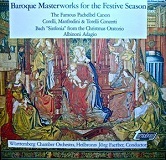 “Baroque Masterworks for The Festive Season” – Württemberg Chamber Orchestra Betcha didn’t see this one coming! Before I discovered rock and roll and the blues, and Return to Forever, and the New Orleans piano professors, and “The Chronic” – I was an 11-year-old classical piano prodigy and this was one of the first records I ever bought with my own money. It’s got the Pachelbel Canon, and the Torelli Christmas Concerto on it. Just get it. It’ll make you weep.
“Baroque Masterworks for The Festive Season” – Württemberg Chamber Orchestra Betcha didn’t see this one coming! Before I discovered rock and roll and the blues, and Return to Forever, and the New Orleans piano professors, and “The Chronic” – I was an 11-year-old classical piano prodigy and this was one of the first records I ever bought with my own money. It’s got the Pachelbel Canon, and the Torelli Christmas Concerto on it. Just get it. It’ll make you weep.
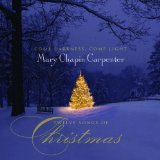 “Come Darkness, Come Light” – 12 Songs Of Christmas” – Mary Chapin Carpenter A dozen original Christmas tunes by one of our great songwriters – not the normal celebratory, sentimental, or breezy types of things you hear this time of year, they are instead reflective and realistic. When you have that seasonal melancholy, and you need to dig deep – this is the one you need to hear.
“Come Darkness, Come Light” – 12 Songs Of Christmas” – Mary Chapin Carpenter A dozen original Christmas tunes by one of our great songwriters – not the normal celebratory, sentimental, or breezy types of things you hear this time of year, they are instead reflective and realistic. When you have that seasonal melancholy, and you need to dig deep – this is the one you need to hear.
 I first heard about the Radio (in my) Head project over a year ago when I met up with a couple of the people involved in putting the album together. It’s fair to say that it’s been a fairly long flash-to-bang time, but the end result certainly is a cracker (sorry). We’ve been publishing fairly regular updates on the album’s progress and reviews of the singles released so far (as well as a few unrelated singles from the artists involved), so the final release could have been an anti-climax; it isn’t, because this is a very, very good album. Normally, I’d give you a bit of background on the artists, but there are eleven of them, so you can find all you need to know here. I try to avoid track-by-track reviews as well, but there really isn’t any choice here, so I’ll start at the beginning, leaving out the songs we’ve already reviewed as singles.
I first heard about the Radio (in my) Head project over a year ago when I met up with a couple of the people involved in putting the album together. It’s fair to say that it’s been a fairly long flash-to-bang time, but the end result certainly is a cracker (sorry). We’ve been publishing fairly regular updates on the album’s progress and reviews of the singles released so far (as well as a few unrelated singles from the artists involved), so the final release could have been an anti-climax; it isn’t, because this is a very, very good album. Normally, I’d give you a bit of background on the artists, but there are eleven of them, so you can find all you need to know here. I try to avoid track-by-track reviews as well, but there really isn’t any choice here, so I’ll start at the beginning, leaving out the songs we’ve already reviewed as singles.
The opening track, “The National Anthem” by STRNGRS, which eases the listener into the album doesn’t depart radically from the “Kid A” original but replaces the funk groove with a rockier, heavier feel, a bass sound that wouldn’t be out of place on a Kasabian track and a vocal with more than a nod in the direction of Brian Molko. You just know that Black Casino and the Ghost will put their own very individual stamp on “Packt like Sardines in Crushed Tin Box” with an incredibly heavy bassline and Elisa Zoot’s breathy but powerful vocals driving the song along; it doesn’t disappoint.
Stoneface Travellers are the first band to really make a song their own with a version of “My Iron Lung” that replaces the original’s “Dear Prudence/ Lucy in the Sky…” guitar sounds with straight ahead blues riffing. Where the original breaks down into a noisy middle section, this becomes quieter ahead of an extended solo from Emile Gerber. It’s the first radically different version on the album. Yoya’s take on “Wolf at the Door” replaces the mainly acoustic instrumentation of the original with samples played backwards and forwards, loads of electronic sounds and a vocal which goes from pure to fractured in the space of one line; it took Marianne Faithfull twenty-five years to do that.
There are good, and very good vocal performances on the first half of the album, but the first truly outstanding vocal is on Amy Hannam’s version of “Street Spirit (Fade Out)”. The song builds gradually from a chiming guitar intro with the piano providing the bass and a very close-miked vocal which demonstrates the quality and power of Amy’s voice, particularly when joined by the perfect harmonies in the chorus. It has a very 70s prog feel at times; there’s a passage where the vocal is reminiscent of Pink Floyd’s “Great Gig in the Sky” and the piano is straight out of “Tubular Bells”. And, yes, it does fade out. Skeye’s version of “Karma Police” again has a retro feel using traditional rock band instrumentation and adding organ to the mix in traditional 70s style. The vocal is pure and clear until pushed hard when it becomes more raw and rocky and it’s another song stamped with the style of the performer.
Malin Andersson’s version of “Exit Music (For a Film)” has electric and acoustic guitars providing the backing for Malin’s breathy vocal (close-miked again) before adding a violin, in contrast to the original’s drums and synths in the final third of the song ; it’s another excellent version. Alexey Zelensky tackles the only non-album track of the project, “Staircase”, which was released on “The Daily Mail” single. Many of the elements of the arrangement are similar to the original, including the UK garage/drum ‘n’ bass drum patterns and chiming guitars but Alexey adds some powerful multi-tracked lead and backing vocals and guitar. And I think you can guess what’s coming at the end of the album.
The closer is Bethan Mills’ version of “Creep” and it’s a classic. I must admit to hearing a demo version of this a few months ago and it’s been really difficult to keep this one secret; it’s a powerful and original take on the song that Thom Yorke seems to hate so much now. The song opens with understated piano before Bethan’s (close-miked again), intimate vocal comes in. Drums and bass kick in after the first chorus, but the vocal still punches through the arrangement. There’s a breakdown back to the opening arrangement on the “Whatever makes you happy…” verse before an epic finish featuring a big guitar solo with squalls of controlled feedback drop out to leave a plaintive vocal to end the song. I’m a huge fan of the Chrissie Hynde unplugged version of “Creep”, but I think this version just shades it in a straight fight.
So, it could have easily been a bunch of tired retreads of Radiohead songs but it’s much, much more than that. Project curator John O’Sullivan has pulled together a bunch of people from all over the world to put their own stamp on their favourite Radiohead songs. Listening to the album for the first time, you have no idea of what’s coming next and the surprises are all pleasant. There aren’t any average tracks here; they’re all well thought-out and very well performed. My personal highlights are Amy Hannam’s version of “Street Spirit” and Bethan Mills’ version of “Creep”, but I’ll happily listen to any song on this album.
The good news is that from October 29, you can hear the album in all its glory by downloading it on iTunes here.
What are the odds on Portis(in my)Head next?


